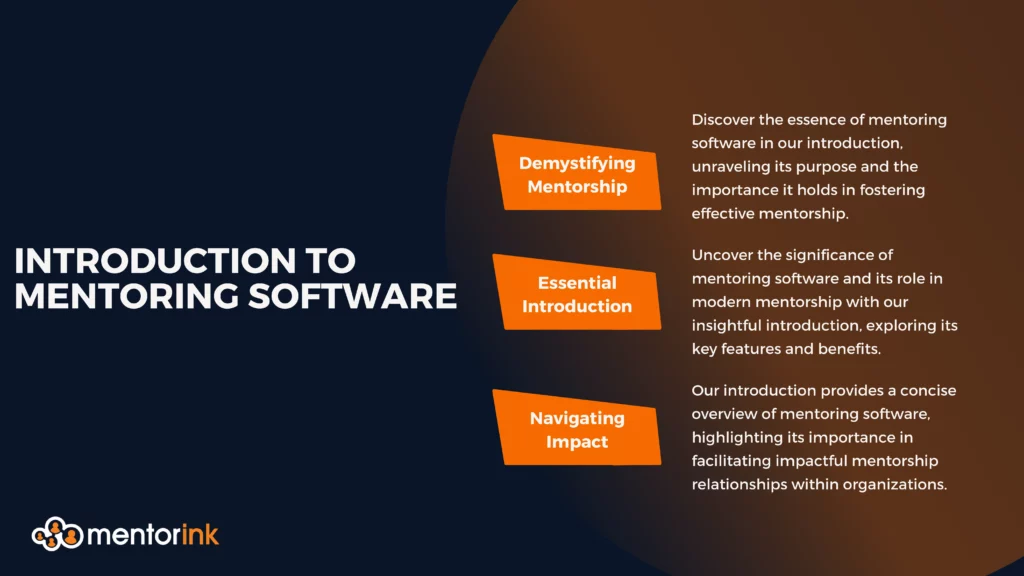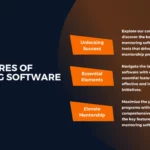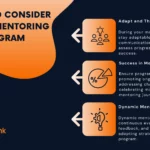
Mentoring stands out as a vital instrument for fostering professional development, enhancing employee engagement, and driving organizational success in professional life. Traditionally, mentoring has been characterized by direct, personal interactions that occurred in person, frequently constrained by location and the availability of time. However, as in every aspect of life, mentoring has also transitioned to a digital environment. Mentoring software has earned the right to play an important role in breaking the boundaries of traditional mentoring.
What is Mentoring Software?
The basic definition of mentoring software refers to a computer application or platform designed to support and facilitate the mentoring process between mentors and mentees. It is a powerful digital tool that simplifies, organizes, and elevates interactions with mentors within organizations or educational settings. In other words, the software automates a variety of administrative tasks linked to mentoring, including the pairing of mentors and mentees, monitoring progress, and offering essential tools for communication and goal setting.
Mentorship software goes beyond just interactions; it also fosters organized settings that enable meaningful and productive mentorship to flourish.
The platform guarantees a mentoring process that is scalable, trackable, and perfectly aligned with your organization’s objectives. It empowers HR managers and program administrators to track the effectiveness of mentoring programs, collect valuable insights, and make informed, data-driven decisions.
Key Components of Mentoring Software
Mentoring software functions as a dynamic digital platform created to facilitate and manage the mentoring journey between mentors and mentees. Mentoring software offers a range of functions, with common features including:
- Application and profile forms
- Matching support
- Goal-setting
- Progress tracking
- Communication via chats, video-calls, calendar sync
- Resource sharing
- Assessments and Feedback
- Reporting and Analytics
- Integration with existing systems like HRIS, LMS, SSO etc
More visual explanations with specific examples can be found on Mentorink software features page
How to Use Mentoring Software?
As a new phenomenon, using mentoring software can be confusing for the new users. But by knowing some features and phases of the software you can use it correctly.
Setup of Mentorship Software
The first step is configuring the software according to your organization’s needs.You should establish clear objectives for the mentoring program, focusing on areas like leadership development, skill enhancement, or career advancement. Administrators will have the ability to tailor workflows, forms, and data fields to meet these objectives effectively.
Participant Registration
Once the program is in effect, employees or students can sign up as mentors, mentees, or both. During the registration process, users often supply information about their talents, professional objectives, interests, and availability. This allows the algorithms to match mentors and mentees successfully.
Mentor Mentee Matching
The mentoring software applies an algorithm to automatically match mentors and mentees based on the information entered during the registration part. Some mentoring platforms like Mentorink additionally have manual matching options, allowing administrators to modify automated choices as needed.
There are two fundamental matching model for mentorship and coaching programs.
- Admin-led matching: where only admins can view and initiate matches manually or system automated.
- User-led matching: where mentees can see the directory of mentors, send their own matching requests, then to be accepted by mentors.
Communication in the Mentoring Software
Once matched, the software has built-in communication features to keep mentors and mentees engaged. Mentors and mentees can communicate effectively by organizing meetings, and sharing materials directly by using the software system. In some advanced mentorship software systems mentors and mentees connect with video conferencing systems, allowing for easy virtual mentoring.
Setting Goals and Tracking of To-Do Lists
One of the mentorship software’s primary benefits is the ability to create goals and monitor progress over time. Mentors and mentees may set their goals, whether they’ll be considered personal development or skill-building goals, and track their progress through the platform.
Giving Feedback
Throughout the virtual mentoring process, mentors and mentees can provide ongoing feedback, allowing them to fine-tune their interactions and ensuring the mentoring relationship is effective. Mentorship program administrators can also create reports on participant involvement, contentment, and overall program success.
“How Mentoring Software Can Help Improving Mentoring Programs?” can help you to learn more about principles of virtual mentorship program.
What are the Advantages of Using Mentoring Software?
Mentoring software can enhance communication and collaboration between mentors and mentees by providing a centralized platform for communication and exchange of information. This can include features such as instant messaging, email, and file sharing.
For the same reason, by having a dedicated platform for communication, mentors and mentees can easily stay in touch and exchange information, reducing the risk of miscommunication or missed messages. Besides mentoring software provides organizations with access to real-time data and insights on mentoring programs, which can help to inform decision-making and improve the performance of mentoring programs. You may also read our blog content about “Common Challenges and Solutions when Using Mentoring Software” to get more information about using of mentorship software.
Mentoring software comes with numerous benefits for both the organization and its employees. They can be listed as follows;
Scalability
One of the main limitations of traditional mentoring programs is their scalability. When organizations develop, manually tracking mentorship relationships may become a logistical nightmare. Mentoring software automates much of this process, allowing businesses to scale their programs more effectively. Whether you have a team of 10 or 1,000 people, the platform can manage many mentor and mentee pairings, analyze progress, and deliver scaled insights. Mentorink has generated success cases to several enterprise organizations for pilot and highly scaled mentorship programs.
Optimized Mentor and Mentee Pairing Process
A mentoring relationship’s success frequently depends on the mentor and mentee’s connection. Mentoring software uses artificial algorithms to match participants based on a variety of factors, including professional history, goals, communication styles, and areas of interest. This promotes more productive and mutually beneficial partnerships, improving the chances of a successful mentorship experience.
Organizations take different approaches here. Some defines their structure and processes from scratch including form questions and matching criteria, some chooses to go with the best practice templates and blue-prints. Mentorink enables both options to give the flexibility to the mentorship program managers.
Mentor and Mentee Connection
Mentoring software provides an organized structure for continuing participation. Goal tracking, auto-reminders, and built-in communication tools help mentors and mentees stay connected and engaged. Best mentoring software promotes a more engaged workforce by addressing common barriers such as scheduling conflicts and geographical limitations.
Monitoring of Mentoring Process
One of the most significant benefits of digital mentoring platforms is the opportunity to assess the program’s effectiveness. Metrics like participation rates, target accomplishment, and feedback scores may all be analyzed using the platform. Managers can utilize these data to evaluate the program’s success, make adjustments, and justify future investment in mentoring efforts.
Boosting of Diversity and Inclusion in the Workplace
In today’s workplace environment, diversity and inclusivity can be considered as vital points to maintain employee engagement. Mentoring software may help organizations foster diversity and inclusion. By removing unconscious bias from the matching process and allowing employees from underprivileged communities to interact with mentors, the software helps to create a more fair workplace.
Flexible Communication
Traditional mentoring frequently needs participants to be in the same location, limiting potential for remote employees or those from other locations. On the other hand, mentoring software removes physical constraints, allowing participants to participate from anywhere in the world.
Cost-Effective Part of Mentorship Software
Because manually managing a large-scale mentoring program can be time-consuming, mentoring software automates most of the administrative labor, making it a cost-effective solution. Automation of tasks like matching, scheduling, and reporting allows organizations to save time and resources.
You can find more details on ROI – Return on Invest of Mentoring programs as well as KPI set of mentoring in a workplace.
Standardization of Mentorship
Mentoring software ensures that all participants have a consistent experience. The organized environment of this program enables a uniform mentoring process, guaranteeing that all mentors and mentees have access to the same resources, tools, and opportunities, which is especially useful in larger businesses.
How Mentoring Software Boosts Employee Engagement
Without sustaining employee engagement, there cannot be any mention of the success of any organization. Mentoring software can play a significant role in enhancing employee engagement.
Personalized Development Opportunities
Mentoring software enables specific development pathways. Employees can collaborate with mentors to identify particular skills they wish to acquire and set customized goals that correspond with their career objectives. This particular focus generates a sense of personal progress and investment, which increases employee engagement and commitment to their roles.
Better Communication Ambient
A lack of meaningful workplace relationships is one of the leading causes of disengagement. This enables continuous interaction between mentors and mentees, assisting employees in developing solid connections that contribute to a sense of belonging inside the organization. When employees feel connected, their engagement naturally rises.
Feedback
Mentoring programs provide opportunities for regular feedback, which is crucial for employee development and engagement. Mentees receive guidance and recognition for their progress, while mentors often feel a sense of fulfillment from helping others grow. This two-way feedback loop boosts morale and encourages higher levels of participation in both mentoring and workplace activities.
Mentoring software has changed the way organizations implement and expand mentoring programs. This type of technology improves engagement, learning, and program outcomes by offering organized, data-driven platforms for mentor-mentee connections. This software helps companies grow and retain top talent by promoting diversity and inclusion and helping employees create adapted growth strategies.
Mentorink makes these benefits real, supporting program managers, mentors and mentees to get the best out of the process and investment.
Sounds exciting?
We would be very happy to support your design and run your mentoring programs
Book your Demo

